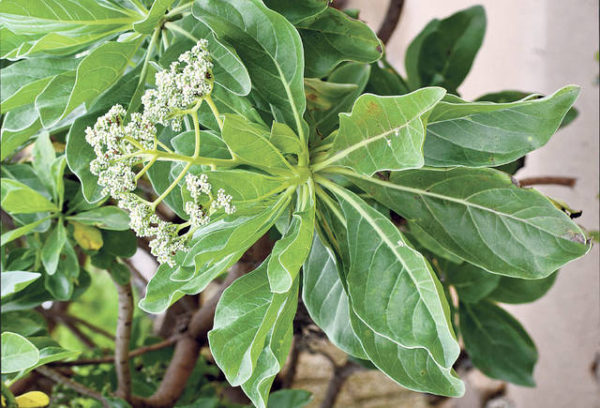Published in the Ocean Watch column, Honolulu Star-Advertiser © Susan Scott
April 28, 2018
Last year several readers who live along Kaneohe Bay wrote that large green sea turtles were hanging out at the shoreline of their waterfront homes.
One reader wrote, “OMG! I mean not just one. I saw at least 10. … They are huge, and their shells have barnacles so you can tell they’re old. They come around 4 p.m.”
Another wrote, “Recently we’ve been seeing sea turtles in a bale (a group of turtles) of eight to 12 coming really close to our waterfront. … Is this normal?”
 A heliotrope tree’s leaves and flowers along the coastline of Punaluu.
A heliotrope tree’s leaves and flowers along the coastline of Punaluu.
©2018 Susan Scott
I didn’t have an answer for those concerned turtle admirers, but last month a team of University of Hawaii and private researchers published a study that offers a clue: The turtles may be coming for fallen leaves.
Hawaii’s green turtles eat over 275 species of seaweed, some sea grasses and several marine animals, such as sponges and jellyfish. But turtle workers have seen turtles on the Kona Coast eat floating leaves dropped naturally by shoreline heliotrope trees.
Heliotrope (HEE-lee-o-trope) comes from the tree’s scientific name, Heliotropium. “Helio” is a Greek word for sun and “trope” means turned toward. But this small tree isn’t as notable for facing the sun (I mean, don’t they all?) as it is for growing in sandy, shallow, salt-soaked soil lacking in nutrients. As a result, heliotropes are common along coastlines in Hawaii.
The tree, however, is not native here. This common species is native to Asia, Australia and the South Pacific islands, and someone unknown brought it to Hawaii. The first mention of a heliotrope tree here was a botanist’s note in 1871. Since then the trees have spread through the Hawaiian Islands, including the atolls of the Northwest chain.
Some island peoples use heliotrope leaves as famine food, medicine, spice and fodder for their livestock. The leaves were previously unknown, however, in green turtle diets.
After seeing turtles munching on heliotrope leaves that had fallen onto the water, Hawaii researchers analyzed dried dropped leaves and found that a pound contains about 2,000 calories. Because that’s more calories than provided by most marine food eaten by green sea turtles, it’s possible that turtles showing up at shoreline breakwaters are there to eat fallen heliotrope leaves.
To answer several other readers’ questions about what to do when they see a turtle hooked or tangled in fishing line, see this recent video link of a man helping a hooked turtle on Kailua Beach: goo.gl/FPx78L.
Bottom line: No, we are not supposed to touch sea turtles, but if you need to do so to save its life, it’s OK. If you come across a struggling turtle, cut the line and leave the hook, which will eventually rust. If it seems as if the turtle needs medical attention, call NOAA’s hotline for help at 888-256-9840.
And if you would like to admire turtles from your waterfront yard, try planting heliotrope trees.